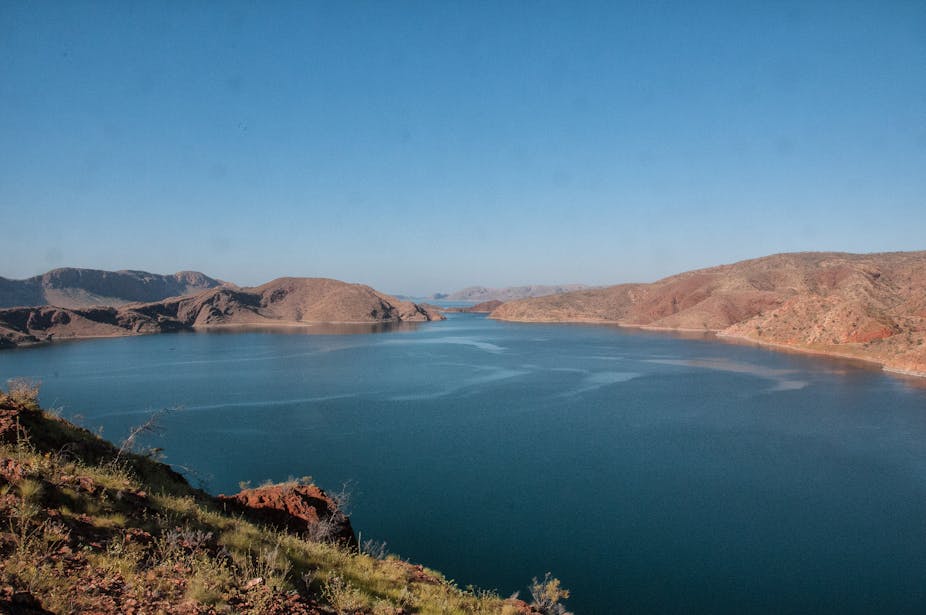Some 27 irrigation and dam projects are highlighted in the green paper for agricultural competitiveness released this week by agriculture minister Barnaby Joyce.
Six of the projects – five in Tasmania, one in Victoria – are considered well-advanced enough to receive federal funding within 12 months. Another 21 will be considered.
The paper highlights investment in water as a priority for the future. While several of the mentioned investments in water efficiency are important, the suggested investment in new dams seems out of place.
Using dams to secure water supply for irrigation is similar to using a sledgehammer to kill a fly. Yes, it will kill the fly, but it is a fairly inefficient way of doing it, and you might destroy other valuable items on the way.
Dams aren’t the best way to store water
Australia needs a strong agricultural sector for vibrant rural communities. Agricultural production in Australia relies heavily on good water management, in plants, in the soil and at the field and farm level.
Drought is a recurring Australian feature, and water security is therefore a key issue for many Australian farmers. Agriculture for the future needs smart solutions to manage water, and soil moisture, to increase the water use efficiency of the production systems.
Dams, due to their physical dimensions, store large amounts of water, but in the Australian environment also lose large amounts of water through high evaporation (particularly in summer) and possible seepage as was also identified by the Irrigation Futures CRC.
A quick back of the envelope calculation suggests that, on a typical summer day with up to 5 millimetres of water lost in evaporation, 1 hectare of water surface could evaporates 50,000 litres of water.
In addition, dams have a limited life span due to sedimentation and are known to have unintended upstream and downstream impacts.
Finally, while dams can provide some buffering of water supply in droughts, in the last Millennium drought this buffering clearly was insufficient as shown by the collapse in irrigated production in cotton and rice between 2000 and 2010.
More specifically in Northern Australia the development possibilities for dams was questioned by experts from CSIRO and the University of Melbourne, because the river flow is so variable in Northern Australia.
Rivers part of a system
Dams also continue the idea that water going to sea is “lost” and could be used more productively. It suggests that water in rivers can be seen separately from water in groundwater, or in plants, or in soil, or in the ocean, rather than seeing all this as one connected system, which is the current scientific paradigm.
In reality, there is no “unused water”, all water is being used in some productive way, either by people or ecosystems, and we can only move water from one productive use to another.
The suggestion of new dams in the agriculture green paper also seems in conflict with the investment in water use efficiency and water buy back in the Murray-Darling Basin, where the impact of dams has been the topic of debate for many years, as evidenced by the debate around the Murray Darling Basin Plan.
Why create new problems, if we are still mopping up from our last effort?
Better ways to manage water
The green paper rightly states that Australia should be delivering a high value agricultural product that is seen as “green, clean and safe”.
In my opinion, this means that Australia requires smart solutions for managing water and drought on-farm, through better crop varieties, more efficient water application, smarter irrigation layouts, better on-farm data collection and interpretation, and more education and training.
This is currently being pursued on farm through reducing water inputs via drip and trickle irrigation, connecting nutrient and water management, better timing of applications, and increasing the use of new technology to save water on farm. This particularly requires easier-to-use technology and better on farm and hands-on training.
The green paper also rightly states: “water availability can also be increased by improvements in existing water infrastructure”. Clearly this is a much smarter way to go: continued investment in improving rural water infrastructure and the efficiency of irrigation enterprises, as well as continued focus on the water market.
The green paper also mentions groundwater augmentation and reuse. This remains a tricky subject, but with more information on groundwater and surface water interaction, there might be opportunities.
Water stored in groundwater is less susceptible to evaporation losses, but there are other problems related to water quality and recovery costs. In addition, over extraction of groundwater is a global issue, and does not create more water for production. However, this is an area that is smart to invest further work.
A step backwards
All of these good ideas are mentioned in the green paper and listed for investment or continued, so it really is puzzling where the need for more dams suddenly came from.
The focus on new dams also seems a move away from the Howard era National Water Initiative (2004) and the National Plan for Water Security (2007), which can now be recognised as major steps forward in national water resource management and had much stronger focus on environmental and social outcomes, and a clear recognition of the interconnectedness of the water cycle.
Dams, however, are nice political statements, they are large and visible, can be opened with fanfare, require investment, labour, and boost the local economy.

